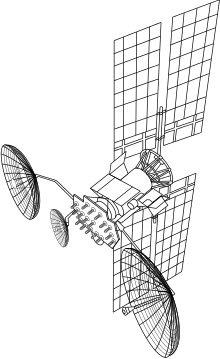Luch (satellite)

The Luch (Russian: Луч; lit. Ray) Satellite Data Relay Network (SDRN), also referred to as Altair and Gelios, is a series of geosynchronous Russian relay satellites, used to transmit live TV images, communications and other telemetry from the Soviet/Russian space station Mir, the Russian Orbital Segment (ROS) of the International Space Station and other orbital spacecraft to the Earth,[1] in a manner similar to that of the US Tracking and Data Relay Satellite System.
History

The first generation of satellites was created by NPO-PM using the satellite platform "KAUR-4" (its first use) and had the code name "Altair" (index GUKOS - 11F669). The system was conceived as part of the second generation of the Global Satellite Data Relay Network (Глобальная Космическая Командно-Ретрансляционная система (GKKRS)) and was developed by decree of the Soviet Council of Ministers of February 17, 1976 (the other part of this decree authorized the construction of geostationary system "Geyser"). Five satellites have been built on this platform, but only four have been launched: Kosmos 1700, Kosmos 1897, Kosmos 2054 and Luch-1, none of which are currently operational.[3][4][5] The fifth satellite has been, due to lack of funds for the launcher, donated to the A.S. Popov Central Museum of Communications in Sankt-Petersburg, Russia.
In the second generation of the satellites, code named “Gelios”, several improvements have been introduced. Nonetheless, due to lack of funds, only one satellite built on this platform has been launched: Luch-2 1 (Gelios-12L) on September 11, 1995 – it stopped working in 1998.
Platform design
Each satellite had a mass of 2.4 metric tons and featured two photovoltaic arrays, providing 1.8 kW of power.[6] Three large antennas and numerous, small helical antennas permitted data relays in the 15/14, 15/11, and 0.9/0.7 GHz bands.[6]
Future launches
The further three satellites, Luch-5A (was launched on 11 December 2011), Luch-5B (2012) and Luch-4 (2013), are planned for launch to rebuild the system and provide the ROS with 45 minutes of coverage per orbit via the Lira and Regul communications systems.[7] The satellites will be built by JSC Information Satellite Systems (previously "NPO-PM") based on the family of the newest satellite platforms "Ekspress-1000" and "Ekspress-2000".[8]
References
- ↑ David Harland (30 November 2004). The Story of Space Station Mir. New York: Springer-Verlag New York Inc. ISBN 978-0-387-23011-5.
- ↑ Portree, David (March 1995). "Mir Hardware Heritage". NASA. Retrieved 24 August 2012.
- ↑ Harvey, Brian (2007). The rebirth of the Russian space program: 50 years after Sputnik, new frontiers. Springer Praxis Books. p. 263. ISBN 0-387-71354-9.
- ↑ Gary Kitmacher (2006). Reference Guide to the International Space Station. Canada: Apogee Books. pp. 71–80. ISBN 978-1-894959-34-6. ISSN 1496-6921.
- ↑ "Luch (Altair)". Gunter’s Space Page. Retrieved 2011-09-20.
- ↑ 6.0 6.1 Mark Wade. "Luch". Encyclopedia Astronautica. Retrieved 11 September 2010.
- ↑ Anatoly Zak (4 January 2010). "Space exploration in 2011". RussianSpaceWeb. Retrieved 12 January 2010.
- ↑ "Multifunctional space data relay system Loutch". JSC "Academician M.F. Reshetnev" Information Satellite Systems". Retrieved 2011-09-20.
| ||||||||||||||||||||||||
